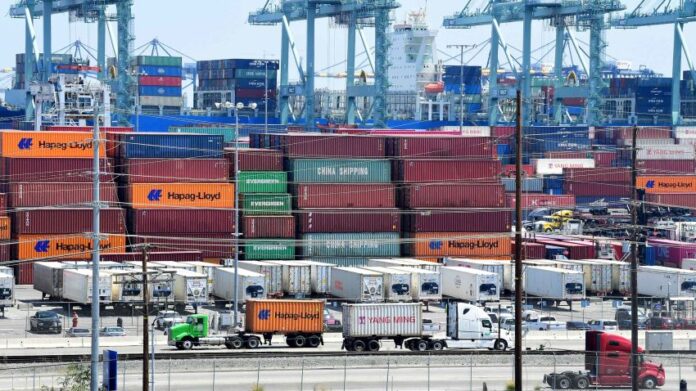In the latest chapter of the US-China trade saga, the Section 301 investigation unfolds with familiar rhetoric but a new narrative. April 17 witnessed the US Trade Representative’s renewed application of the “Section 301”, this time aimed at China’s maritime, logistics, and shipbuilding domains. Concurrently, the Biden administration has also called for substantial hikes in import tariffs on Chinese steel and aluminum wares.
These actions mark perilous strides by Washington, propelling the USA and China further into a quagmire of escalating trade hostilities. They not only misconstrue, but potentially distort China’s manufacturing prowess, deviating starkly from the bedrock principles underpinning the World Trade Organization (WTO).
The risk is not merely economic; it jeopardizes the delicate fabric of international relations, demanding judicious recalibration to avert further discord. Under the guise of national security concerns, the USA is framing routine trade and investment as existential threats to American interests. US Trade Representative Katherine Tai echoes these sentiments, decrying China’s alleged transgressions as the scourge behind the USA’s industrial woes. Yet, a closer appraisal reveals a narrative at odds with reality. The purported desolation of American industries rings hollow when imports of Chinese steel barely register on the economic radar and Chinese electric vehicles remain a rarity on US roads, hampered by hefty tariffs.
As the rhetoric escalates, it’s imperative to sift through the hyperbole and discern the true impact on American workers and industries, separating fact from political posturing in the tumultuous realm of international trade. In the current milieu of geopolitical tensions, the rhetoric emanating from Washington paints a stark portrait of China, laden with allegations bereft of substantial evidence.
However, China’s response, characterized by candor and steadfastness, reflecting its commitment to fair play and transparency in trade affairs. The trajectory of China’s manufacturing sector speaks volumes, a narrative of innovation and market dynamism. It is unequivocal: China’s industrial ascent is a product of enterprise ingenuity and spirited engagement in global commerce. Amidst the cacophony of accusations, the delineation between right and wrong remains unambiguous. Washington’s attempts to vilify China through a litany of accusations are a transparent cloak for its own protectionist and unilateral agenda. The invocation of Section 301 and the imposition of tariffs have not only flouted WTO regulations but also met with widespread condemnation from the international community.
As history echoes, this latest bout of antagonism will be no exception. Amidst Washington’s recent barrage against China’s manufacturing sector, the spectre of electoral calculus looms large. The Biden administration’s pivot appears tailored to court favour with blue-collar voters in pivotal swing states. Yet, beneath this veneer lies a deeper truth: America’s failure to grapple with China’s industrial rise. “Made in China” symbolizes not just a label, but a paradigm shift in global economic dynamics.
As titans of industry, China and the USA must join hands to safeguard the stability of the global economic web, fostering growth with mutual regard and equitable gains. It’s imperative for the US administration to acknowledge China’s manufacturing prowess, embrace the tenets of globalization, and eschew hasty deployment of punitive measures like the “Section 301” tool. Such gestures mark the genesis of a more symbiotic rapport, essential for a harmonious economic landscape.
Without a nuanced comprehension of this reality, the trajectory of Sino-American trade relations risks derailment. As the US grapples with its own introspection, the path forward demands a recalibration of strategy— one grounded in mutual understanding and constructive engagement. China’s manufacturing prowess, particularly in heavy sectors like steel and shipbuilding, mirrors the natural evolution of global economic integration. This ascent, marked by resilience and ingenuity, underscores China’s formidable competitive edge.
Leveraging its expansive market, robust infrastructure, and innovative drive, China has surmounted hurdles en route to industrial preeminence. However, coerced growth, devoid of fairness, risks stifling the true potential of “Made in China.” Washington, cognizant of its own industrial decline stemming from protectionist policies, must heed this cautionary tale. Sustainable progress demands a departure from unilateralism towards a framework of mutual cooperation, ensuring the vitality of global manufacturing landscapes.
Amidst the turbulence plaguing America’s traditional manufacturing sector, Washington is facing a serious challenge demanding self-introspection. Rather than weaponizing this crisis for electoral gain or scapegoating China, it’s imperative to confront the root causes. How to rejuvenate flagging industries and transition from virtual to tangible economic growth are paramount national concerns. Blame-shifting offers no solutions; instead, embracing globalization’s currents and honouring comparative advantage principles are pathways to sustainable progress. Washington’s penchant for protectionism risks exacerbating the plight of struggling sectors.
A pragmatic approach entails fostering industries aligned with domestic strengths, rather than propping up uncompetitive players. In this era of economic flux, adaptation, not obstructionism, is the key to fortifying America’s industrial landscape and safeguarding its global competitiveness. In the realm of global economics, China’s trajectory is undeniable. Its strides in economic openness have propelled it forward, a path it remains resolute in pursuing.
As titans of industry, China and the USA must join hands to safeguard the stability of the global economic web, fostering growth with mutual regard and equitable gains. It’s imperative for the US administration to acknowledge China’s manufacturing prowess, embrace the tenets of globalization, and eschew hasty deployment of punitive measures like the “Section 301” tool. Such gestures mark the genesis of a more symbiotic rapport, essential for a harmonious economic landscape.





















